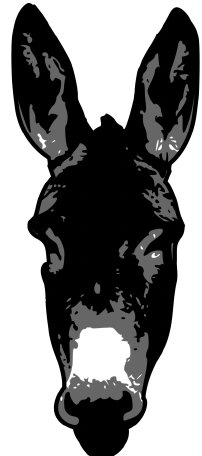 The original railroad town of Laws had a depot of course, and the Station Agent’s House at Laws has been there since 1883. It did not have a mule barn. The Carson and Colorado Railroad in fact largely took the place of the mule freighters who hauled ore from the Owens Valley mines for more than a decade before steam locomotives appeared on the horizon. But before trains, mules ruled. And a very good job they did indeed.
The original railroad town of Laws had a depot of course, and the Station Agent’s House at Laws has been there since 1883. It did not have a mule barn. The Carson and Colorado Railroad in fact largely took the place of the mule freighters who hauled ore from the Owens Valley mines for more than a decade before steam locomotives appeared on the horizon. But before trains, mules ruled. And a very good job they did indeed.
The Mule Museum at Laws is the culmination of work by the Death Valley Conservancy and others dedicated to the history of the role of mules in the colorful and complex story of Owens Valley history. Bishop, “Mule Capitol of the World,” has hosted the Mule Parade each Memorial Day weekend since 1970, but even many locals are unaware of the astonishing and extensive role mules have played in our local history and culture.
In Owens Valley’s 20 th Century, Mules have hauled equipment and supplies to build the aqueduct to divert water to the City of the Angels, brought materials for the South Lake and Lake Sabrina dams, and hauled construction components for wagon and automobile roads, electrical, telegraphic, and telephone lines. Surrounded by public lands, we have employed mules to build trails for the U.S. Forest Service and National Park Service, and to promote pack trips for tourists visiting these lands. We would not be who we are without the help of these four-footed beasts of burden. Mules: stronger, smarter, more tolerant of privation, and more capable of withstanding harsh conditions than horses, were brought to this land by Columbus in 1495, and promoted by George Washington as the answer to the needs of the new Nation’s farmers. Mules were essential to Western Expansion: the longest commer-cial pack train in America was the 1,200-mile Old Spanish Trail connecting Santa Fe and Los Angeles from 1821-1849.
Even earlier, mules were equally important in the success of Eastern California mining. Death Valley’s Twenty Mule Team Borax wagons and mules have been immortalized by Hollywood, but long before mule freighting began in Death Valley, Borax was being shipped by longline teams of 14-24 mules from Western lake beds to the nearest railroad connection at Wadsworth Nevada, over miles of treacherous terrain. French-Canadian mule freighter Remi Nadeau---not the only but arguably the most famous mule freighter--- hauled ore from Cerro Gordo to the ports of San Pedro, returning with equipment and supplies for miners (the resulting exponential growth of Los Angeles led to needs for more water, and, well, the rest is history, and the “water wars” are documented elsewhere). The Southern Pacific Railroad made its way to Mojave in 1876, shortening the journey, and by 1883, the Carson and Colorado Railroad arrived in Bishop, and the colorful era of mule freighting faded into history.
Twenty Mule Team Borax of course came into commercial consciousness later, in 1892, followed by Hollywood’s Death Valley Days in the 1930s. Thus, our patient, plodding, four-footed partner in the script of Western History, this cross between a donkey (male) and horse (female) rides with us through the pages of Western History. Come visit the Mule Museum at Laws, and celebrate this intelligent creature that helped weave the threads of mining, ranching, and railroading into our Owens Valley History!
Reprinted from "The Mail Car" membership newsletter, November 2023
